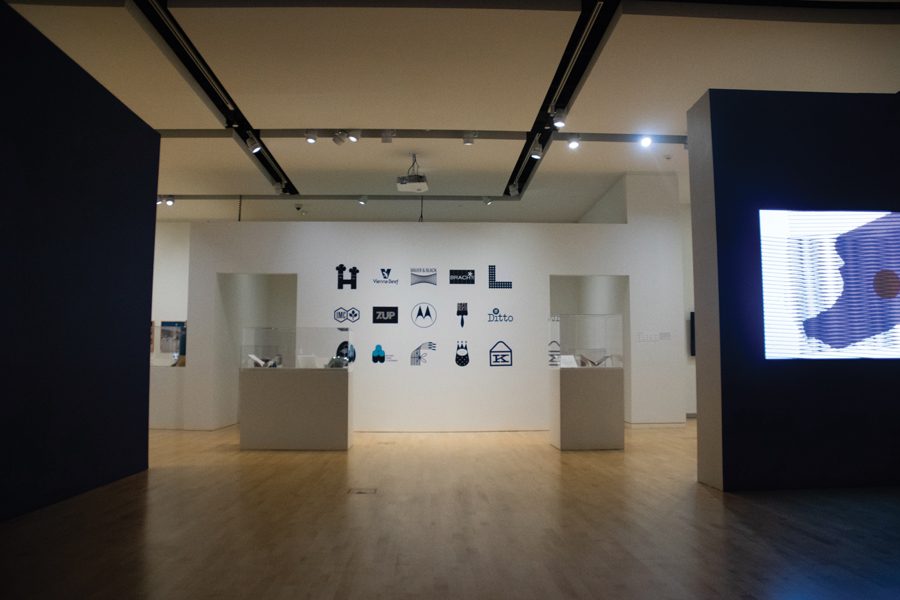Advertisement trailblazers’ work featured in Block Museum exhibition
Rachel Kupfer / Daily Senior Staffer
The Block Museum presents “Up is Down: Mid-Century Experiments in Advertising and Film at the Goldsholl Studio,” an exhibition reintroducing the work of influential advertising firm Goldsholl Design Associates. The exhibition features some of the Goldsholls’ most famous designs for companies such as Motorola, 7UP, and Kimberly-Clark.
October 3, 2018
Iconic advertisements can be found everywhere, from a can of 7Up in the fridge to the classic Motorola flip phone in the palm of your hand.
As the inventors of these cultural staples, Morton and Millie Goldsholl know that firsthand.
In the new art exhibition “Up is Down: Mid-Century Experiments in Advertising and Film at the Goldsholl Studio,” the Block Museum of Art uncovers a powerful force that fostered the modern form of advertising and corporate branding—namely, the Chicagoan advertising firm Goldsholl Design Associates. The exhibition runs from Sept. 18 to Dec. 9 and is part of Art Design Chicago, a yearlong celebration exploring Chicago’s art and design legacy.
Goldsholl Design & Film Associates was run by married duo Morton and Millie Goldsholl, said NU alum Amy Beste, a co-curator of the exhibition. The Goldsholls were mid-century artists who employed Bauhaus techniques in well-known corporate campaigns by experimenting with new materials, focusing on light as a medium and emphasizing the craft of film, she said.
“I think the two major innovations that the firm made was in corporate identity design, creating what we now think of as branding,” Beste said. “They were also innovative in terms of applying avant garde ideas to commercial, advertising or corporate-sponsored films, so that these films look unlike anything else at the time.”
Beste said she was most fascinated with how the exhibition illustrated the “screen culture” of the 1950s, which the Goldsholls capitalized upon by pairing it with their knack for advertising. After the war, screens became a normal part of everyday life and the film industry flourished, she said. Chicago was considered “the Hollywood of industrial filmmaking,” and movies were shown everywhere from theaters to classrooms and stores.
Naturally, the Goldsholls turned to television to influence the relationship between screen space and the outside world, Beste said. They were pioneers in moving design onto this contemporary medium, she said.
Corinne Granof, the exhibition’s other co-curator, said the Goldsholls’ spirit of experimentation was well-received by corporations. As television and graphic design jobs broke into the professional realm, companies needed ways to keep viewers watching during commercial breaks—carving a space for the Goldsholls’ unique ads.
Granof said the exhibition is also a testament to the historical context the Goldsholls worked in.
“Morton and Millie founded the firm in the mid-50s, and…the fact that Millie had such a prominent role in the firm and in their commercial and professional work was unusual, because as a woman, it was not as typical or common,” she said. “So just to see her as a principal leader and in a creative role is inspiring.”
Block Museum Communications Manager Lindsay Bosch, who worked with the curators to bring new audiences to the exhibition, said the show is particularly compelling for audiences because it touches on both Chicago’s history and the Bauhaus movement in America, she said.
These crowds will also find the Goldsholls’ successful advertisements relatable and reminiscent, Bosch said.
“Quite a lot of people have held their Motorola phones in their hands, and the Goldsholls designed that ‘M’ logo,” Bosch said.”Even if you have never heard of them as artists, even if you don’t know about modernism or experimental art of the midcentury, you realize that you’ve encountered it in your life.”
Email: [email protected]
Twitter: @dreamertorii


